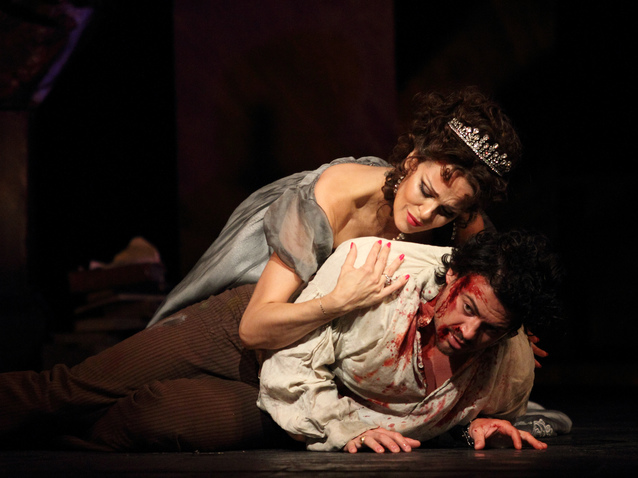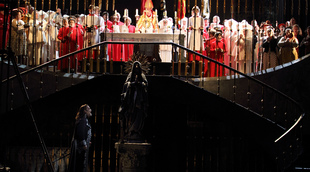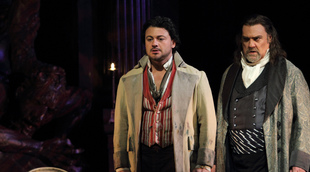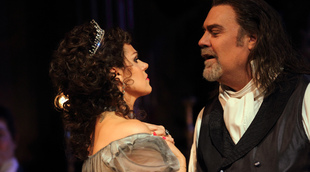 © ROH 2019 photograph by Catherine Ashmore
© ROH 2019 photograph by Catherine Ashmore
Based on Victorien Sardou’s 1887 French-language play, Giacomo Puccini’s Tosca of 1900 not only occurs in a specific time and place, but on a precise date that can be linked to an historical event. All of the action takes place during the afternoon, evening and early morning of 17 and 18 June 1800, following the Battle of Marengo between Napoleon’s army and Austrian forces. The Austrians were initially triumphant and sent news of victory back to Rome, but the city’s celebrations were cut short when a later report revealed that Napoleon subsequently mustered reinforcements and actually inflicted a crushing defeat.
Tosca is set across the hours when the contradictory messages arrive in Rome. Angelotti, a consul of the city when it was a republic but a prisoner since Neapolitan forces began to occupy it, escapes from the Castel Sant’Angelo and turns to the painter Cavaradossi to hide him. Rome’s Chief of Police, Baron Scarpia, attempts to squeeze information as to Angelotti’s whereabouts from Cavaradossi’s lover, the celebrated singer Floria Tosca. She is naturally prone to jealousy and Scarpia exploits this, as well as the situation as a whole in order to fulfil his own love for her.
After Scarpia sentences Cavaradossi to death for hiding a fugitive, Tosca promises the Chief to give herself to him if she will release her lover and allow both of them to leave Rome. Scarpia agrees, explaining that he still needs to appear to have killed Cavaradossi, and so (apparently) instructs his agent to stage a mock execution, after which they can both escape. As soon as Scarpia has written out their passport, however, Tosca stabs him to death. At the subsequent execution Tosca discovers all too late that Scarpia tricked her, and that Cavaradossi was shot with real bullets. As news of Scarpia’s murder spreads Tosca leaps off the parapet of the Castel Sant’Angelo and plunges to her death.
One of the most heart wrenching aspects to Tosca is the very fact that a singer and painter who at the start of the story are simply going about their daily lives should find themselves thrust into a situation that spirals out of control so quickly that within twenty-four hours both are dead. Indeed, whether we assign the point of no return to Cavaradossi’s initial decision to help Angelotti, or to the moment when Tosca determines to head to his villa, which ultimately leads Scarpia’s forces to both men, their fates feel largely sealed by the end of Act I before the sun has even gone down.
Jonathan Kent’s production for the Royal Opera House, which started life in 2006 and is now enjoying its tenth revival (from Andrew Sinclair), brings out the tragedy to the full as it sees every set work around some form of curve. Act I presents the shadowy side of Rome’s Sant’Andrea della Valle, with the Attavanti chapel where Angelotti initially hides lying both behind and below the church’s main altar. From the audience’s vantage point the nave and chancel stand above the stage, with marble columns and candles proclaiming beauty and light. In contrast, the lower level offers a ‘behind the scenes’ glimpse of the church, where different artistic and architectural styles vie for attention. There is an ancient Corinthian capital (upon which a statue of the Madonna stands), and the painting Cavaradossi is working on appears opposite the faded remains of a medieval Last Judgment fresco that presumably survives from an earlier church on the site.
It is within this more cluttered area that the church as an institution is shown to be imperfect, which in the context of the Neapolitan occupation derives from its virtual inseparability from police and state. During a recitation of the ‘Te Deum’ when the choir and crowd sing to the heavens above, Scarpia alone occupies the entire lower level revealing how, in practice, he rules over all three of these domains.
The late Paul Brown’s set actually places the church at a slight angle to the auditorium, and this asymmetrical trend is continued in Act II when Scarpia’s apartment in the Palazzo Farnese is based around two curves that cross one in front of the other. Interestingly, the only shelves to bear books at all are those that hide the room where Cavaradossi is tortured and even these turn out to be fake. Act III’s scene of execution on the ramparts of the Castel Sant’Angelo is dominated by a low curved parapet that only runs down one side of the stage, and creates a suitably hostile moonlit area.
If, however, the concept and design create a strong starting point, the cast play a key part in fulfilling all of the desired effects. The three main principals are especially good, with no criticism that might be levied against any of their performances ever undermining the ultimate strength of them. As Cavaradossi, Vittorio Grigòlo reveals an extremely large and expansive tenor that is thrilling to hear. There are moments in ‘E lucevan le stelle’ when his cutting off of notes seems very deliberate and, though they are well within the realms of acceptability, it does not make for the smoothest of performances that would really draw us in. More generally, the directness of his sound seems to go hand in hand with a characterisation that does not seem so nuanced.
Nevertheless, his cries of ‘Vittoria!’ when the news reaches Rome that the Austrians have actually been defeated are especially convincing as one really feels his courage in defying Scarpia at a time when doing so can only end badly for him. Grigòlo’s acting in Act III also reveals that he knows he will not be getting out of the situation alive, although it is more than just his words and expressions that reveal this. When Tosca shows him their passport he actually quashes it with his foot when he believes that she slept with Scarpia in order to obtain it. However, once he discovers the truth he makes no effort to retrieve it, because by now he knows that Tosca will not be escaping either because Scarpia’s body will be discovered soon enough. Such an idea ties in with his behaviour in the opera because if Cavaradossi thought Tosca had any chance of surviving he would be urging her to flee immediately. Believing her to be doomed, however, he encourages her to picture their future happiness as if it were now to ensure that her final moments are beautiful ones.
Kristine Opolais sings Tosca beautifully, with her soprano feeling exceptionally well shaped, controlled and nuanced. All this makes for an especially accomplished performance of ‘Vissi d’arte’, which benefits from feeling as reflective as it does emotional, so that we really can believe she is the good person she ultimately claims to be. Similarly, when she bosses Cavaradossi around in Act I it is with enough humour to suggest that she has the self-awareness to know what she is like. This, in turn, suggests that her jealousy is not such a terrible trait, and one that normally she can contain. This only makes it all the more tragic to think that, at a moment when she does let it get the better of her, it actually causes everyone’s downfall. Grigòlo’s more assertive and Opolais’ more reflective sound do not necessarily make for the best blend of voices, but overall they work far better together in Act III than Act I.
Bryn Terfel, with his splendid bass-baritone, is an immensely experienced and effective Scarpia. On the one hand, he feels as brutal and cruel as any we are likely to see, and yet he can come across as such a charmer that when he bows to Tosca as she exits the church in Act I he almost convinces us that he might be a decent person. Terfel also reveals how the Chief of Police actually feels vulnerable by being so intoxicated by Tosca. This is because it is a shock to a man who is so used to controlling everything around him to discover that he cannot actually control himself. Terfel’s portrayal also suggests that, although Scarpia knows it is his power that will win him Tosca and he is not afraid to use it, deep down he would have loved it if she had genuinely reciprocated his feelings.
Alexander Joel’s conducting is highly engaging, with Act II in particular conveying a real sense of drama, and the string playing that precedes ‘E lucevan le stelle’ being especially fine. The direction also remains strong to the very end. The opening to Act III sees soldiers casually going about their business, which actually enhances our own sense of trepidation as to what might befall Cavaradossi as he faces execution. The manner in which the soldiers march on to shoot him and then retreat also works brilliantly with the music. It simultaneously captures the routine nature of their business from their own point of view, the fear felt by Tosca despite believing everything will be all right, and our own absolute sense of impending doom. As the curtain falls, three of the plot’s survivors can do nothing but take a few awkward steps. This only emphasises their own sickening sense of shame at the fact that all of the giants, the evil ones included, have now passed on.
Angela Gheorghiu plays Tosca and Marco Vratogna Scarpia for some performances over the current run, while the opera also returns to the Royal Opera House in July 2020 with Anna Netrebko as Tosca, Brian Jagde as Cavaradossi and Bryn Terfel as Scarpia once more.
By Sam Smith
Tosca | 27 May – 20 June 2019 | Royal Opera House, Covent Garden
the 29 of May, 2019 | Print



Comments